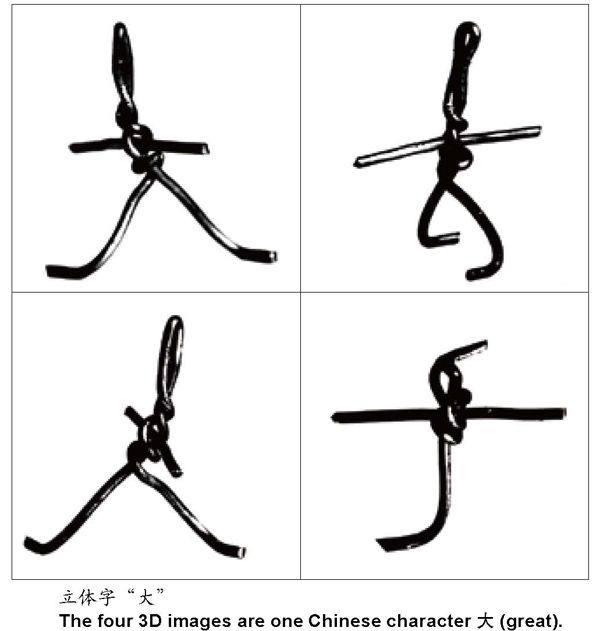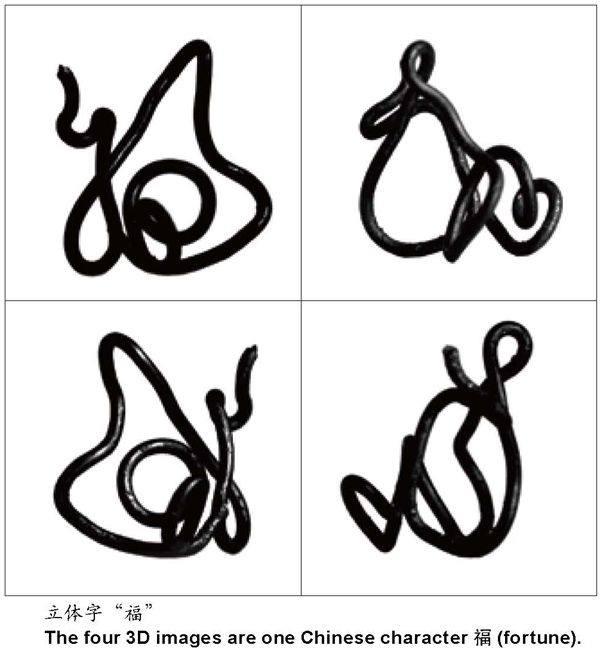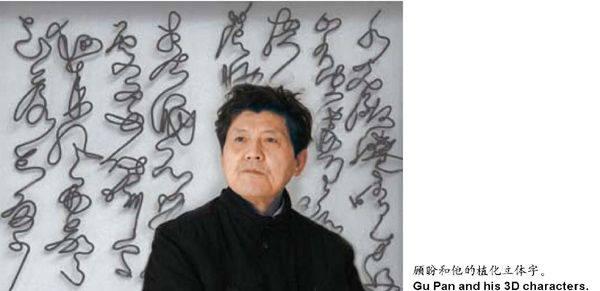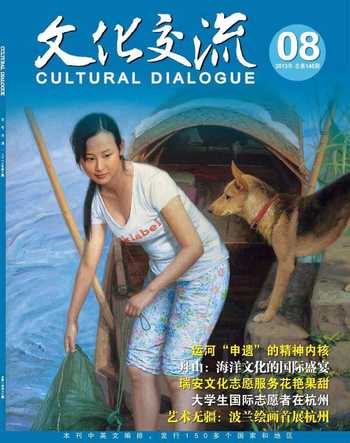植物艺趣 顾盼神飞
2013-04-29申菡
申菡



他有着扎实的科班背景,以历史画和肖像画创作见长,用油画、中国画、素描以及综合材料等形式多次参加过全国美术展览。可正是这样一位“传统”画家,近年来却又把目光投向了“不传统”的艺术形式—汉字立体化,希望以此作为突破口,拓展现代植物化融绘审美理念。
为了了解这“植化”旨趣,我拜访了他—在艺术天地中神飞的顾盼。
孜孜不倦的求索者
落座,顾盼饶有兴味地请我品茶,然后不紧不慢地拿出一只硕大的盒子让我观看。盒子里是他最新创作的两幅作品—孟浩然《春晓》“春眠不觉晓,处处闻啼鸟。夜来风雨声,花落知多少”和苏轼《饮湖上初晴后雨》“水光潋滟晴方好,山色空蒙雨亦奇。欲把西湖比西子,淡妆浓抹总相宜”两首诗的汉字立体造型。他介绍说,每句诗都用一根铁丝一气扭曲而成,从正面看,颇有狂草的意味;从侧面或后面看去,却是多个抽象的立体影像,生发出植物独特的盘根错节之美。我觉得确乎如他所说:顺笔意立体架构,稳重心拟人拟树;含汉字之韵味,添多视角之艺趣。
28年前,顾盼在《美术》《文艺报》等报刊上发表文章,提出美术的发展应充分重视科技对美术的推动(简称“借力说”)。经多年研究,他认为,在21世纪以科技带动人类发展的总理念下,要重视植物对人类生存的影响。中国的传统艺术譬如绘画,不管是花鸟还是山水,大都寄托着人对植物的情思,其内核是对“植物精神”的崇拜。不仅绘画如此,而且在中医学、诗歌、音乐、武术甚至哲学中都能见到其影响,这是数千年中国农业文明对人类的重要贡献。而他现在创作的这批汉字立体雕塑,从本质上来说正是追求植物精神的产物。
“我翻看了您的画册,发现在传统油画创作之余,您很早就开始把植物精神融于画中,创作一些可称是‘新锐的作品。但是,您又是怎样想到把汉字作为这类创作对象的呢?”我问。
“这还要从1986年说起。”顾盼开始了他的回忆,“当时,我随一艺术团体赴美考察,在华盛顿遇见一位华人老者,带着一个六七岁的孩子。交谈过程中,这孩子很激动,想和我们大人说上几句。孩子的英语说得很溜,但讲中国话的时候,就疙里疙瘩不知怎么表达,碰到说不下去的地方,干脆哭了起来。”
顾盼觉得,孩子这样的表现很明显是受到了语言的限制,而哭,则是对母语的依赖。顾盼继而想到,即使是在国外长期生活,华人的子孙辈仍然对母语有着浓厚的兴趣。那位老人后来告诉顾盼,每个星期天,一家人就会带着孩子去私立汉语学校补习,“不这样,他以后就不会讲中国话了”。
这件事情至今让顾盼记忆犹新。从那时,他开始萌生发掘汉字本身艺术价值的想法。“中国有书画同源之说,传统绘画的核心元素乃是书法和文字的架构样式,以汉字立体化作为突破口,使文字的含义与形式在特定的时空中变异、绵延、拓展,即在特定的角度看是被立体化了的汉字,而从侧面、背面等其他角度看是种种抽象的雕塑。”再后来,他从新兴的电脑、网络文化中获得启发,把自己多年研究的植物化融绘理念和汉字结构结合起来进行创作。拿他的话说,就是“用植物化的心态,把在绘画、雕塑中的经验用于书法、汉字的立体构建,还原植物的姿态”。
心怀诗书的传播者
“传播”是访谈过程中,顾盼话里出现频率最高的一个词。
2011年,浙江人民美术出版社出版了顾盼的《植化融绘论》一书,书中阐述了以植物化的心态观看万物的新的绘画理念与样式,并展示了一条从绘画逐步拓展到雕塑、现代设计艺术与建筑等方面的艺术实用之路。顾盼希望他的艺术发现能够被多数人接受。他说:“汉字立体化构建的传播,是有利于中华文化在全世界的传播的,有利于国家软实力的增强。”
对于汉字立体构建应用于实际,顾盼已经思索出很多可能的概念,比如灯具、过山车、玩具的创意;景观中的诗句雕塑、书法雕塑、指示方式设计等等,可以根据场地要求,采用不同内容,运用楷书、草书和篆书的不同字体,灵活多变,实用又好看。
国际上,比如在孔子学院里,可以出现“师”字;在华人居住区,可以出现“荷”字;在华人商贸区,可以出现“福”字。而国内,公园景观里可以用山水诗句,城市景观可以用宣传语;还有许多日用品、家具也可以加入汉字的立体雕塑创意元素。
顾盼具体举例:“像‘师字,各种材料都可以制作,如用墨竹种植的话则可被认为是‘生态雕塑,更能突显出21世纪重归自然的发展理念。”他说,“植化融绘论除开拓立体思维外,还可以开拓人的多方位认识事物的能力。”
“像在杭州,孤山靠着里西湖那片大草坪上,就可以出现汉字的‘杭或者‘西湖等字样,配合LED的灯光效果,让外地游客在北山路、宝石山上就能看到美轮美奂的作品。”
对于这些应用,顾盼已经有了很多实用性成果的展示。他拿出了自己在杭州市科协、上海杨浦区教师进修学院讲学用的相关课件、其他模型、多座植物与人形体态合一的石膏像让我欣赏。看着这些资料,一个为自己的艺术理念而四处推广的形象浮现眼前。顾盼说,美国当今提出要重新开展对植物的研究,这不仅是植物学家的事,而且要多学科综合研究植物对人类的影响,预测其对人类美术的发展必成一重要因素。“多年来,传统艺术都处于被保护、被收藏的地位,为什么?因为这些艺术形式和生活脱钩,不实用。要真正保护传统艺术,就必须找出路让它们实用起来。”
顾盼总结说,今天的中国对外交流更加频繁,我们要在汉字书法与国际抽象艺术间,推出世界通用的对话语言。
(本文图片由顾页提供)
The Art of Making 3D Chinese Characters
By Shen Han
A college-bred artist, Gu Pan is by no means an artist who follows orthodox ideas. His career has covered some unique fields. His favorite themes are history and portraits and his art output includes oil paintings, traditional paintings, sketches and sculptures. In recent years, he has tried to make a breakthrough in making 3-dimentional Chinese characters. His newest enthusiasm may define him as a sculptor.
The other day, Gu Pan and I had a chat over a cup of tea. He showed me a large box. Inside were two 3D Chinese-character pieces. One piece was a 20-character poem entitled Spring Dawn by Meng Haoran (a poet of the Tang Dynasty 618-907) and the other a 28-character poem entitled Sipping Wine on the Lake Shortly After Rain by Su Shi (a poet of the Song, 960-1279). Though each had different word count, the two has something in common: each is a piece of four lines. What makes a piece wonderful is that each line is made of a long piece of iron wire. Examined from the surface, the characters are in the wildest cursive script. Examined from behind or sideways, the abstract images are like intertwined roots of a tree.
Gu Pans new art dates back to 28 years ago when he published essays in national art publications calling for artists to get inspirations from science and technology for breakthroughs. Now he believes plants should play a big part in art. With a history of an agricultural society for millennia, Chinese people identify with plants.
His focus on Chinese characters came from a personal experience during his visit to America. He met with an old man in Washington. With the old man was a child probably six years old. During Gus chat with the old man, the boy was eager to join the conversation but he was clumsy with Chinese words even though he was fluent in speaking English. The boy wept, totally frustrated by his failure to speak Chinese. Gu later learned from the old man that the boy attended a private Chinese course on Sundays in the hope that he would grow up to speak Chinese. Gu Pan later thought a lot about the experience and tried to figure what it meant.
One conclusion he reached was that he as an artist needed to explore the artistic value in Chinese characters. Chinese artists and calligraphers agree that painting and writing are from the same root. Traditional painting regards calligraphy and character structures as the core elements of painting. A three-dimensional character can be a sculpted work of art and can present a form that expands the original meaning and beauty of a character.
His latest endeavor now incorporates his ideas about characters and his love for plants.
For him, three-dimensional structures of Chinese characters can take various forms. Lamps and toys can be made to display Chinese characters. He even imagines that a standing rail structure for a roller coaster in a theme park can take the form of one or a few Chinese characters. Sculpture can easily handle Chinese characters in various scripts. For example, Confucius Institutes across the world can present a sculpture image of 师 (teacher). A residential community where Chinese people live, a sculpture of 荷 (lotus) can add beauty. 福 (fortune) will be most appropriate in a shopping street where shops operated by Chinese businesspeople gravitate. Gu Pan even suggested some designs of his 3D Chinese characters for scenic spots of the West Lake in Hangzhou.
Gu Pan is a theorist eager to apply his ideas to the real world. He showed me a few of his practical designs, including some models he had used in his lectures at Hangzhou Science Society and Shanghai Yangpu District Teachers College.
Gu Pan explains why he thinks traditional art needs preserving. He points out that it is like an endangered species simply because it is totally divorced from life and impractical. The best way to preserve traditional art is to find ways to use it in everyday life.
